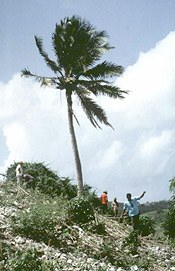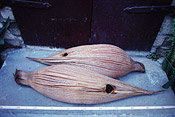Why is this species important?
This attractive palm is similar in appearance to the African oil palm. It is of particular interest to botanists due to its unique flower structure and unusual distribution as all other species of Attalea are confined to Central and South America.
Where is it found?
Attalea crassispatha is found only on the south-western peninsula of Haiti on the island of Hispaniola in the Caribbean. It is one of the rarest palms in the region and is thought to be on the brink of extinction in the wild. In 1996 there were estimated to be no more than 30 individuals left in the wild. A. crassispatha occurs in degraded, hilly areas with four major population centres at Fond-des-Nègres, the lower Cavaillon/Boulmier river watersheds, Fond-des-Blancs and the Bonne Fin/Gros Marin river watersheds.
How do people use it?
The nut of this palm is a rich source of fat and is highly prized as a food and cooking oil. The trunk is durable and insect resistant and is used occasionally in construction. The longevity and architecture of any solitary palm makes it a favourite landmark and boundary marker for farmers.
Why is it threatened?
A. crassispatha is threatened by encroaching agriculture. Habitat is converted to other uses and the practices of slash and burn and free grazing do not favour natural regeneration. Three habitats have been identified where A. crassispatha grows: fields, courtyard gardens and shrub forests. Fields normally consist of mixed annual crops that are converted to pasture after several years. Palms have little chance of survival in these habitats, as the pressure is too high for natural regeneration. In secondary shrub forests there is heavy local land pressure and the forest is likely to be harvested for charcoal and then converted to fields. Courtyard gardens may provide the best chance of survival for A. crassispatha. Over-harvesting of the nuts from this palm is a further problem A final threat is from the periodic severe storms that affect the area. In 1998, a mature palm was blown down during Hurricane Georges. Young A. crassispatha appear to be sensitive to flooding conditions.
What conservation action is needed?
Conservation efforts have concentrated on planting palms and collecting seeds from adult trees to provide a source of seedlings and in 1998, FFI funded such a project on Haitian palms through its 100% Fund. Planting of A. crassispatha began in the 1980s and continues to this day. A small grove of 25 palms has recently been planted at the Fairchild Tropical Garden. In 1998, one of the trees in this garden fruited for the first time, probably the only time this has happened outside Haiti. In 1998 an additional 21 individuals were planted at various locations throughout Haiti. In 1998, about three kg of fruit was harvested from three individuals and taken for propagation as seedlings. The seedlings that germinate from these seeds will be targeted towards group plantings on secure public and private property in Haiti. Much more educational work needs to be done, involving NGOs and schools. The survival and growth of seedlings that have been planted needs to be closely monitored, as does the fate of naturally regenerated seedlings.
Selected references
Johnson, D., (ed.) 1996. Palms. Their conservation and sustained utilization. IUCN/SSC Palm Specialist Group. IUCN, Gland. 116 pp.
Timyan, J.C., 1999. Palm in Peril: Conservation of the native palms of Haiti. Phase 1. Unpublished report to Fauna & Flora International, Cambridge.
Timyan, J.C. and Reep, S.F., 1994. Conservation status of Attalea crassispatha (Mart.) Burret, the rare endemic oil palm of Haiti. Biological Conservation, 68, 11-18.
Local contacts
Fondation Botanique d’Haiti
5 Imp. Lavaud
Port-au-Prince
Haiti
Tel: +509 245 1608 |
 |


|